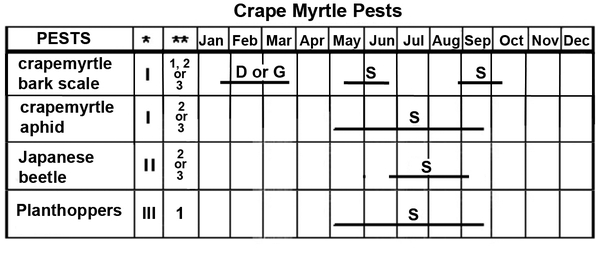Caution
This information was developed for North Carolina and may not apply to other areas.
Please click on the thumbnail to enlarge it.
Jump to the table legend.
Legend
* Degree of importance of pest: I = Important pest, high probability of occurrence, II = Treat as needed: III = Occasional pest, treat when detected.
** Number of applications needed for most effective control. It is usually best to wait 10 to 14 days between applications in cool weather and 7 to 10 days between applications in warm weather.
D = drench application
G = granular application
S = spray application.
Other Resources
- Aphids on Ornamental Landscape Plants. Frank, S. 2009. Entomology Insect Notes, NC State Extension Publications.
- Citrus Flatid Planthopper. Baker, J. R. 2013. PDIC Factsheets, NC State Extension Publications.
- Crapemyrtle Bark Scale. Baker, J. R. 2023. NC State Extension Publications Fact Sheet.
- Crape Myrtle Society of America
- Insect and Related Pests of Shrubs. Baker, J. R. ed. 1980. NC Agricultural Extension Service publication AG-189. 199 pp.
- Japanese Beetles on Ornamental Landscape Plants. Frank, S. and J. R. Baker. 2009. Entomology Insect Notes, NC State Extension Publications.
- Planthoppers. Frank, S. D. et al. 2000. Entomology Insect Notes, NC State Extension Publications.
- North Carolina Agricultural Chemicals Manual
- NC State Extension Plant Pathology Publications and Factsheets
- NC State Horticultural Science Publications
Find your local N.C. Cooperative Extension county center.
This Insect Note has not been peer reviewed.
Crape Myrtle Pest Management Calendar
| Pest | Degree of Importance of Pest* | Number of applications** | Jan | Feb | Mar | Apr | May | Jun | Jul | Aug | Sep | Oct | Nov | Dec |
|---|---|---|---|---|---|---|---|---|---|---|---|---|---|---|
| crapemyrtle bark scale | I | 1, 2, or 3 | Drench or Granular | Drench or Granular | Drench or Granular | Spray Application | Spray Application | Spray Application | ||||||
| crapemyrtle aphid | I | 2 or 3 | Spray Application | Spray Application | Spray Application | Spray Application | Spray Application | |||||||
| Japanese beetle | II | 2 or 3 | Spray Application | Spray Application | ||||||||||
|
Planthoppers |
III | 1 | Spray Application | Spray Application | Spray Application | Spray Application | Spray Application |
* Degree of importance of pest: I=Important pest, high probability of occurrence, II=Treat as needed: III=Occasional pest, treat when detected. ↲
** Number of applications needed for most effective control. It is usually best to wait 10 to 14 days between applications in cool weather and 7 to 10 days between applications in warm weather. ↲
Publication date: Jan. 22, 2019
Reviewed/Revised: Nov. 8, 2023
Recommendations for the use of agricultural chemicals are included in this publication as a convenience to the reader. The use of brand names and any mention or listing of commercial products or services in this publication does not imply endorsement by NC State University or N.C. A&T State University nor discrimination against similar products or services not mentioned. Individuals who use agricultural chemicals are responsible for ensuring that the intended use complies with current regulations and conforms to the product label. Be sure to obtain current information about usage regulations and examine a current product label before applying any chemical. For assistance, contact your local N.C. Cooperative Extension county center.
N.C. Cooperative Extension prohibits discrimination and harassment regardless of age, color, disability, family and marital status, gender identity, national origin, political beliefs, race, religion, sex (including pregnancy), sexual orientation and veteran status.

